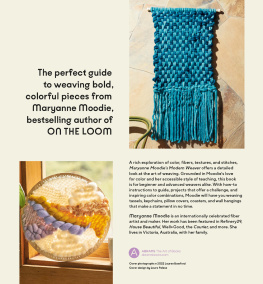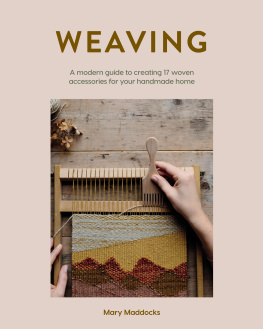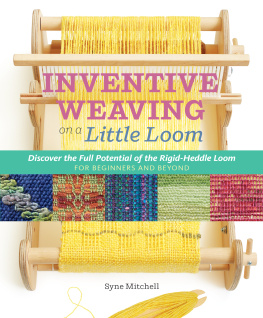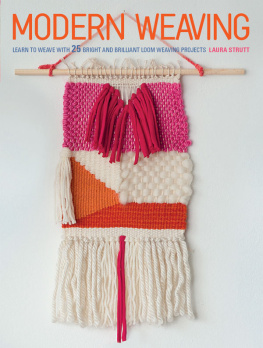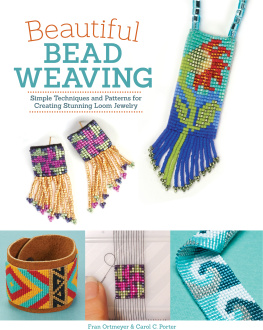ON THE LOOM
A MODERN WEAVERS GUIDE
BY Maryanne Moodie
PHOTOGRAPHS BY Alexandra Grablewski


CONTENTS
INTRODUCTION
I HAVE ALWAYS LOVED vintage textiles. The youngest of six, I spent a lot of time with my siblings in charity shops, scouring the racks for secondhand clothes and toys. The experience was like being in Aladdins caveyou never knew what treasures lay beneath the next layer. Even as a child, I was drawn to handmade, heavily embroidered, and sequined fabrics and clothes, all of which caught my eye and fired up my imagination. As I grew, I loved them more because I began to notice and appreciate the marks that the past had left on themsome darning here, a replaced button thereclues that they had been loved, a little hint that there had been lives lived alongside these beautiful treasures.

I began my career in teaching, much of it in art education, and I taught for more than ten years. I loved teaching art, because it allowed me to impart both knowledge and skills, as well as share in the joy of creating with my students. The most exciting aspect for me was observing how every student brought his or her own unique vision to each task, and I enjoyed seeing how differently everyone interpreted and applied the skills I shared. But I still couldnt get enough of textiles, so alongside my teaching career, I began to build a small business sourcing and selling exquisite vintage clothing and homewares. Both paths taught me so much about building a community, being open to opportunities, trusting your instincts, forgiving yourself, and the logistics of running an honest and environmentally sustainable business.
Then I became pregnant with my first son, Murray. When the time came to go on maternity leave, I needed to clean out the art storeroom. This took me back to my days of childhood charity shoppingthere was treasure to be found under the years of layers. Beneath the piles of paper and supplies, I discovered a small loom that was intended for the trash bin. Although I didnt really know what it was or how it worked, something spoke to me on a deep level: The loom connected with my passion for vintage and my desire to create. There was a hole in the top of the box, so I wasnt even sure if the loom had all of its parts, but the conviction was strong, so I rescued it.
Being at home as a new mother can be one of the hardest and most isolating times, and it can be challenging to your energy, sanity, health, and sense of self. After my son was born, I found myself struggling to adapt to a new life with a different identity. I was no longer a teacher. I had put my business on hold. And I was exhausted and overwhelmed.
One day in 2012, as my little babe slept, I remembered the loom. I pulled it out and read the instructions. I didnt have any yarn, so I warped up the loom with jute and used waxed neon cord to weave myself a swatch of fabric. Immediately, I was hooked. That small instruction manual didnt get me far, so I started teaching myself new techniques from snippets I found on the Internet, and finally I moved on to vintage weaving textbooks sourced from eBay and used bookstores. My beginning as a weaver was a fumbling comedy of trial and error. I would bumble along and invent new stitches, only to discover later that generations of weavers had been using that same technique for hundreds of years. I pored over vintage textile inspiration and tried my hand at creating different effects. Every time I sat down to begin a new piece, I would push myself to try a new skill, incorporate a new fiber, and mix colors in unexpected ways. I wanted to draw deeply on the nostalgic quality of vintage wall hangings while breathing fresh life into them with surprising color and texture combinations.
Weaving turned something on inside me. I felt like I wanted to know more, do more, be more involved. So I began sharing my work on social media, to try to connect with other artisans. Immediately, I received supportive feedback from a community of amazing women. At first, most of them were customers from my vintage-clothing business, who already appreciated the aesthetic of a woven wall hanging with vintage roots. But slowly, my tribe grew. Through the Internet, I began making connections with other weavers, spinners, dyers, and makers. I discovered a whole community of people out there who had been able to make meaningful connections, support one another, and grow together. I felt like I was coming out of the darkness and being welcomed into my new identity as a mother and a maker. It felt great.
As time went on, I was able to draw on my experience teaching in the arts, my passion for weaving, and the joy of community-making by sharing my knowledge in sold-out workshops around the world. I like to keep the vibe of the classes accessible to complete novices as well as people who want to get back into working with fibers after a long absence. Just like in my art classroom, I encourage people to find their own voice. I teach everyone the same building blocks or skills and watch, excitedly, as they use these skills to create new and unique projects that are all very different from one another. I encourage my students to weave weird and try to push the boundaries of what they think is possible. By sharing my knowledge, I am able to learn through my students.
Now, as much as I would love to, I could not possibly travel to all of the wonderful cities in the world to share my knowledge in person. Everyone needs to start somewhere when learning a new skill, and the best place is at the beginning. When I first started weaving, I had no one to talk to about how much I loved it, or to discuss where to find resources, or to celebrate tiny achievements. My husband says that Ive built a weaving cult for the purely selfish reason of wanting to talk about weaving and fibers with like-minded people. Hes right. So this book is for youlet it be your entry point or introduction to weaving, a book of inspiration that teaches you and helps you to begin and to find your own tribe. Get your looms out, flip to a place in this book that piques your creative interest, and get ready to make some new and exciting projects!

TOOLS AND SUPPLIES
WEAVING TREADS THE LINE between art and craft. As a craft, there are enough rules to follow to get new weavers into a comfortable rhythm, while giving rule-breakers many opportunities to have a little fun. As an art, the umbrella of styles, fiber options, and project types is so wide that anyone can create a piece that suits their particular tasteminimalists can create clean projects in neutral tones, experimentalists can create explosions of color and texture. But regardless of why you want to get into this craft, first you have to learn the basics!

LOOMS
ALL WOVEN PROJECTS START WITH A LOOM. A loom an essential part of the weaving processit is the structure that stretches and holds your framing threads (also known as the warp; see ) organized and held at the right tension, while you interlace or weave your other threads (weft) into them. This is how the final fabric, or cloth, is created. When you are done with your weaving, you typically remove your project from the loom and display it separately. Hence, a loom is a tool used in weaving and does not necessarily remain with the final product.


